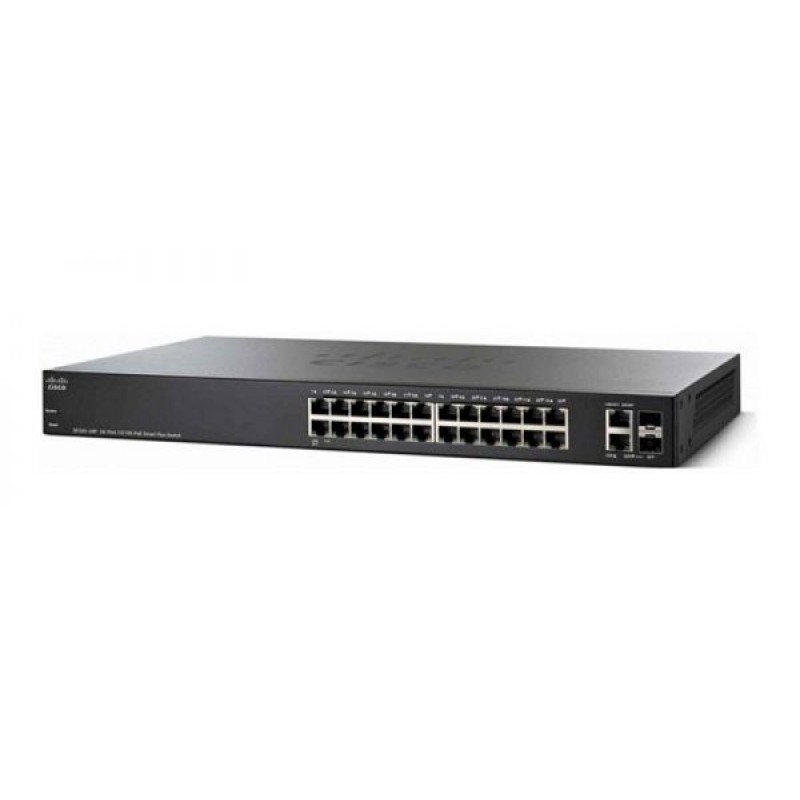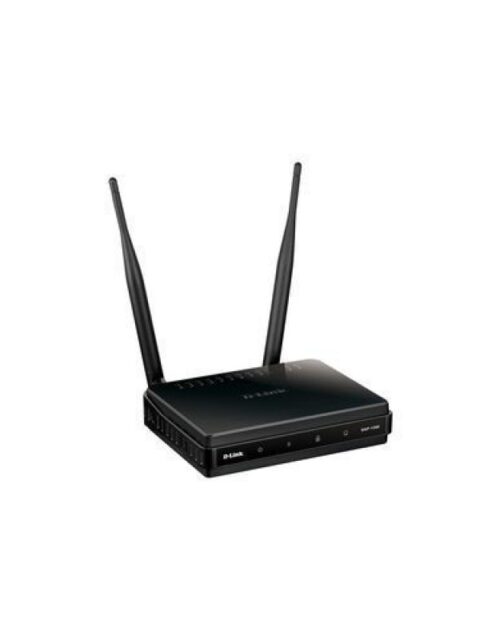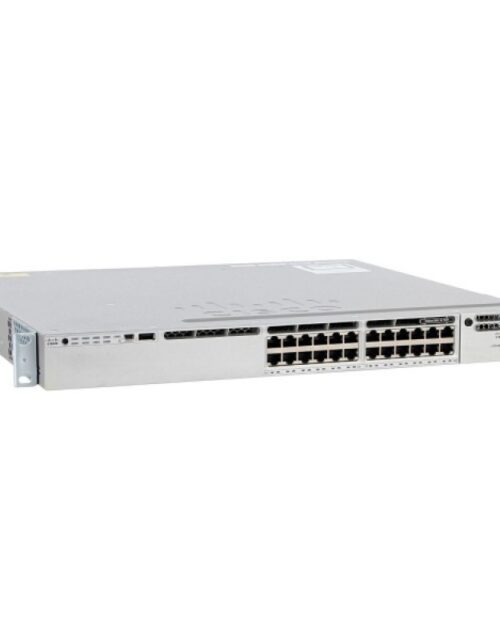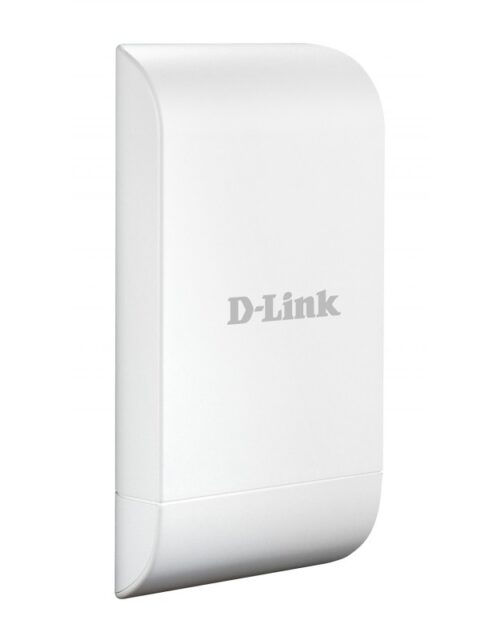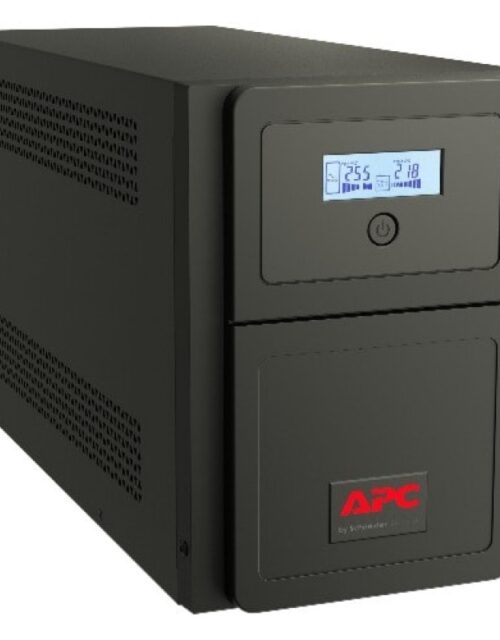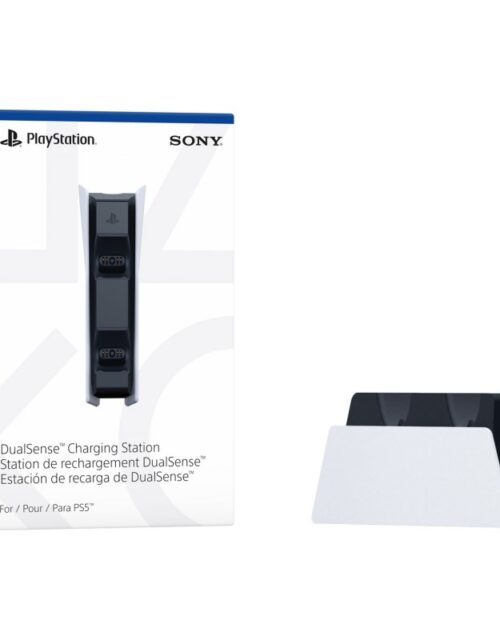PRODUCT SPECIFICATIONS:
| Features / filters | |
| LAN standard | Gigabit Ethernet 10/100/1000 Mb/s, 10 Gigabit Ethernet, |
| Number of LAN ports | 24x [10/100/1000M (RJ45)] , 2x [1/10G (RJ45)] , 2x [10G (SFP+)] , |
| Management | CLI – Command Line Interface, By web browser, |
| Numbers of pieces in the package | 1-pack |
| Switching layer | 2+ |
| Type of case | Rack (1U) |
Technical data – model SG250X-24
| 802.3at PoE+ and 802.3af PoE | |
| Number of ports supporting PoE | None |
| Power dedicated to PoE | None |
| Energy consumption (max.) | |
| Green power | EEE, Energy Detect, Short Reach |
| Energy consumption of the system | 29.1 W |
| Energy consumption (with PoE) | None |
| Heat distribution (BTU/hr) | 99.29 |
| Physical ports | |
| Total number of ports | 24 x Gigabit Ethernet + 4 x 10 Gigabit Ethernet |
| Ports RJ-45 | 24 Gigabit Ethernet |
| Combo ports (RJ-45 + SFP) | 2 x 10 Gigabit Ethernet + 2 x SFP+ |
| Other product specifications | |
| USB connector | USB Type A socket on the front panel of the switch makes it easy to manage files and images |
| Buttons | Reset button |
| Cabling | UTP category 5 or higher for 10BASE-T/100BASE-TX UTP category 5e or higher for 1000BASE-T |
| LEDs | System, Link/Act, PoE, Speed |
| Flash Memory | 256 MB |
| CPU | 800 MHz ARM |
| CPU memory | 512 MB |
| Package buffer | 12 Mb |
| Physical characteristics | |
| Supported SFP/SFP+ modules | MGBBX1, MGBSX1, MGBLH1, MGBLX1, MGBT1, GLC-LH-SMD=, GLC-BX-U=, SFP-H10GB-CU1M, SFP-H10GB-CU3M, SFP-H10GB-CU5M, SFP-10G-SR, SFP-10G-LR, SFP-10G-SR-S, SFP-10G-LR-S |
| Dimensions | 440 mm x 44 mm x 257 mm |
| Weight | 2.66 kg |
| Power supply | Input 100 to 240 V 50 to 60 Hz, internal, integrated |
| Certificates | UL (UL 60950), CSA (CSA 22.2), CE, FCC Part 15 (CFR 47) Class A |
| Ambient temperature during operation | 0°C to 50°C |
| Storage temperature | -20°C to 70°C |
| Ambient humidity during operation | 10% to 90%, relative, non-condensing |
| Humidity during storage | 10% to 90%, relative, non-condensing |
| Noise level and average time between failures (MTBF) | |
| Fan (quantity) | 1 |
| Noise level | 0°C to 30°C: 32.6 dB 50°C: 44.9 dB |
| MTBF at 50°C (in hours) | 130255 |
| Guarantee | |
| Guarantee period | Limited, lifelong |
| Package | |
| Package contents | Cisco 250 series smart switch Power cable (power supply for 8-port and 10-port units) Mounting kit Brief instruction manual |
| Performance | |
| Capacity in millions of packets per second (mpps), 64-byte packets | 95.23 |
| Switching capacity in gigabits per second (Gbps) | 128.0 |
| Switching layer 2 | |
| Spanning Tree Protocol (STP) | Support for 802.1d spanning tree Default 802.1w enabled (Rapid Spanning Tree [RSTP]) Multiple instances of Spanning Tree using 802.1s (MSTP) 8 instances are supported |
| Port grouping / link aggregation | Support for IEEE 802.3ad Link Aggregation Control Protocol (LACP) ● up to 4 groups up to 8 ports per group with 16 candidate ports for each aggregated dynamic link 802.3ad LAG |
| VLAN | Supports up to 256 active VLANs simultaneously VLANs based on ports and tags 802.1Q VLAN network management Guest VLAN |
| Voice VLAN | Voice data is automatically assigned to a voice specific VLAN and processed using appropriate QoS rules. |
| Generic VLAN Registration Protocol (GVRP) and Generic Attribute Registration Protocol (GARP) | Protocols for automatic expansion and configuration of VLANs in a bridged domain |
| IGMP (versions 1, 2 and 3) snooping | IGMP limits high-bandwidth multicast traffic to requesters only; supports up to 4K multicast groups (Source-specific multicast SSM is also supported) |
| IGMP querier | Querier IGMP is used to operate the Layer 2 snooping switches multicast domain in the absence of a multicast router |
| Head-Of-Line (HOL) blocking | Prevention of HOL blockades |
| Feedback loop detection | Feedback loop detection provides loop protection by transmitting loop protocol packets from ports where loop protection has been enabled It works independently of STP |
| Layer 3 Routing | |
| Routing IPv4 | IPv4 packet forwarding at Internet connection speed Up to 32 static routes and up to 16 IP interfaces |
| Routing IPv6 | IPv6 packet forwarding at Internet connection speed |
| Layer 3 interface | Layer 3 interface configuration on physical port, LGD, VLAN or loopback interface |
| Classless Interdomain Routing CIDR | Support for CIDR |
| DHCP relay on layer 3 | Transmission of DHCP traffic between IP domains |
| UDP relay | Transmission between layer 3 domains to detect the use or transmission of bootP/DHCP packets |
| Security | |
| SSL | Secure Sockets Layer (SSL) encrypts all HTTPS traffic, allowing secure access to a browser-based graphical management interface |
| Secure Shell Protocol (SSH) | SSH is a secure replacement for Telnet connections Secure Copy (SCP) also uses SSH SSH v1 and v2 are supported |
| IEEE 802.1X (authorization function) | RADIUS authentication, guest VLAN, single/multiple host mode and single/multiple sessions |
| Secure Core Technology (SCT) | The switch will receive and manage processes and protocol traffic regardless of the amount of traffic received |
| Secure Sensitive Data (SSD) | Mechanism to manage sensitive data (such as passwords, keys, etc.) and securely place it in the switch, deliver it to other devices and securely auto-configure it Access to view confidential data in plain text or encrypted text is provided according to the user configured access level and user access method |
| Port security | Possibility to block sources of MAC addresses to ports and limit the number of known MAC addresses |
| RADIUS | Supports RADIUS authentication for management access The switch acts as a customer |
| Storm protection | Transmission, multicast and unknown unicast |
| Prevention of DoS | Prevention of Denial-of-Service (DoS) attacks |
| Access Control Lists (ACLs) | Packet rejection and delimitation based on source and destination MAC, VLAN ID or IP address, protocol, port, Differentiated Services Code Point (DSCP)/IP precedent, source and destination ports TCP/UDP, 802.1p priorities, Ethernet type, ICMP packets, IGMP packets Support for up to 512 rules |
| STP feedback protection | Provides additional protection against layer 2 transmission loops (STP loops) |
| Quality of Service | |
| Priority levels | 8 queues |
| Planning | Strict priority and Weighted Round-Robin (WRR) based on DSCP and service class (802.1p/CoS) |
| Class of service | Port based; 802.1p based on VLAN priority; IPv4/v6 priority, service type (ToS) and DSCP based; DiffServed services; ACL classification and recharging, trusted QoS |
| Limitation of transmission speed | Ingress policer; outbound bandwidth limiting and bandwidth control; VLAN-based, port-based and flow-based |
| Avoiding congestion | TCP congestion avoidance algorithm is required to limit and prevent losses of global TCP synchronisation |
| Standards | |
| IPv6 | |
| Standards | IEEE 802.3 10BASE-T Ethernet, IEEE 802.3u 100BASE-TX Fast Ethernet, IEEE 802.3ab 1000BASE-T Gigabit Ethernet, IEEE 802.3ad Link Aggregation Control Protocol, IEEE 802.3z Gigabit Ethernet, IEEE 802.3x Flow Control, IEEE 802.3 ad LACP, IEEE 802.1D (STP), IEEE 802.1Q/p VLAN, IEEE 802.1w RSTP, IEEE 802.1s Multiple STP, IEEE 802.1X Port Access Authentication, IEEE 802.3af, IEEE 802.3at, RFC 768, RFC 783, RFC 791, RFC 792, RFC 793, RFC 813, RFC 879, RFC 896, RFC 826, RFC 854, RFC 855, RFC 856, RFC 858, RFC 894, RFC 919, RFC 920, RFC 922, RFC 950, RFC 951, RFC 1042, RFC 1071, RFC 1123, RFC 1141, RFC 1155, RFC 1157, RFC 1213, RFC 1215, RFC 1286, RFC 1350, RFC 1442, RFC 1451, RFC 1493, RFC 1533, RFC 1541, RFC 1542, RFC 1573, RFC 1624, RFC 1643, RFC 1700, RFC 1757, RFC 1867, RFC 1907, RFC 2011, RFC 2012, RFC 2013, RFC 2030, RFC 2131, RFC 2132, RFC 2233, RFC 2576, RFC 2616, RFC 2618, RFC 2665, RFC 2666, RFC 2674, RFC 2737, RFC 2819, RFC 2863, RFC 3164, RFC 3411, RFC 3412, RFC 3413, RFC 3414, RFC 3415, RFC 3416, RFC 4330 |
| IPv6 | IPv6 host mode IPv6 via Ethernet Dual IPv6/IPv4 stack IPv6 neighbor and Router Discovery (ND) Automatic configuration of the IPv6 address MTU (Path Maximum Transmission Unit) detection Duplicate address detection (DAD) Internet Control Message Protocol (ICMP) version 6 IPv6 via IPv4 with support for Intrasite Automatic Tunnel Addressing Protocol (ISATAP) Gold certificate USGv6 and IPv6 logo |
| IPv6 QoS | Prioritization of IPv6 packets |
| IPv6 ACL | Packet rejection or IPv6 speed limiter |
| Multicast Listener Discovery (MLD v1/2) snooping | Delivering IPv6 multicast packets only to selected receivers |
| Management | |
| IPv6 applications | Web/SSL, Telnet server/SSH, Ping, Traceroute, Simple Network Time Protocol (SNTP), Trivial File Transfer Protocol (TFTP), Simple Network Management Protocol (SNMP), Remote Authentication Dial-In User Service (RADIUS), Syslog, DNS client, DHCP client, DHCP autoconfig |
| User interface | Built-in switch configuration tool for easy configuration of devices in the browser (HTTP/HTTPS) Supports configuration, system desktop, system maintenance and monitoring Basic and advanced mode for maximum performance |
| Smart Network Application (SNA) | Innovative network level monitoring and management tool – built into Cisco 250 to 550X series switches It enables detection of network topology, link status display, event monitoring, configuration, updating software images using multiple switches on the network |
| SNMP | SNMP 1, 2c and 3 versions with SNMP Traps support SNMP 3 based on the User Security Model (USM) |
| Remote monitoring (RMON) | The built-in RMON program supports 4 RMON groups (history, statistics, alarms and events) for monitoring, analysis and better traffic management |
| Dual IPv4 and IPv6 stack | Coexistence of both piles of protocols to facilitate migration |
| Firmware update | Web browser update (HTTP/HTTPS) and Trivial File Transfer Protocol (TFTP) Dual images for flexible firmware updates |
| Port cloning | Traffic at a port can be reflected in another port for analysis using a network analyser or RMON probe Up to 4 source ports can be mirrored to one destination port |
| VLAN mirroring | Traffic from a VLAN can be reflected in another port for analysis using a network analyser or RMON probe Up to 4 source VLANs can be mirrored to one destination port |
| DHCP (options 12, 66, 67, 82, 129 and 150) | DHCP options allow tighter control from a central point (DHCP server) to obtain the IP address, auto-configuration (with download of configuration file), DHCP relay and host name |
| Secure copy (SCP) | Safely transfers files to and from the switch |
| Auto-configuration with SCP file download | Enables mass deployment with protection of sensitive data |
| Text-based configuration files | Configuration files can be edited with a text editor and downloaded to another switch to facilitate mass deployment |
| Smartports | Simplified configuration of QoS and safety functions |
| Auto Smartports | Automatically applies intelligence delivered through Smartports roles to the port based on devices detected by Cisco Discovery Protocol or LLDP-MED |
| Command-Line Interface (CLI) | Scriptable CLI Full CLI is supported, as well as menu-based CLI Supported user rights levels 1, 7 and 15 for CLI |
| Cloud services | Support for Cisco FindIT Network Manager and Cisco Active Advisor |
| Built-in FindIT network probe | Support for the built-in FindIT Network Probe operating on the switch Eliminates the need to configure separate hardware or virtual machine for FindIT Network Probe on site |
| Agent Cisco Network Plug and Play (PnP) | The Cisco Network Plug and Play solution provides a simple, secure, consistent and integrated offer to facilitate the introduction of new branches or campus equipment, or the delivery of updates to an existing network The solution provides a consistent approach to delivering Cisco routers, switches and wireless devices with near-zero touch |
| Energy efficiency | |
| Other forms of management | Traceroute; single IP management; HTTP/HTTPS; RADIUS; port mirroring; TFTP update; DHCP client; Simple Network Time Protocol (SNTP); cable diagnostics; Ping; syslog; Telnet client (SSH support); automatic time settings from Management Station |
| Detection of energy consumption | Automatically turns off the power to the RJ-45 port when a missing connection is detected Active mode is resumed without packet loss when the switch detects that the link is active |
| Cable length detection | Adjusts signal strength according to cable length, reduces power consumption for shorter cables |
| Compliance with the requirements of EEE 802.3az | Supports IEEE 802.3az on all RJ45 Gigabit Ethernet ports |
| LED switch-off for ports | LEDs can be manually switched off to save energy |
| Temporary use of the port | Lifting or deactivating the port based on a user-defined schedule |
| Temporary PoE | PoE power can be switched on or off based on a user-defined schedule to save energy |
| Frame sizes and MAC addresses | |
| Jumbo frames | Frame sizes up to 9K bytes The default MTU is 2K bytes |
| MAC Table | Up to 8000 addresses |
| Discovery | |
| Bonjour | Bonjour protocol support |
| Connection Layer Detection Protocol (LLDP) (802.1ab) with LLDP-MED extensions | LLDP allows the switch to broadcast its identification, configuration and capabilities to adjacent devices that store data in MIB LLDP-MED is an LLDP extension that adds extensions needed for IP phones |
| Cisco Discovery Protocol | The switch is broadcast via the Cisco Discovery Protocol View brief information about connected Cisco network devices, IP phones and wireless access points |

